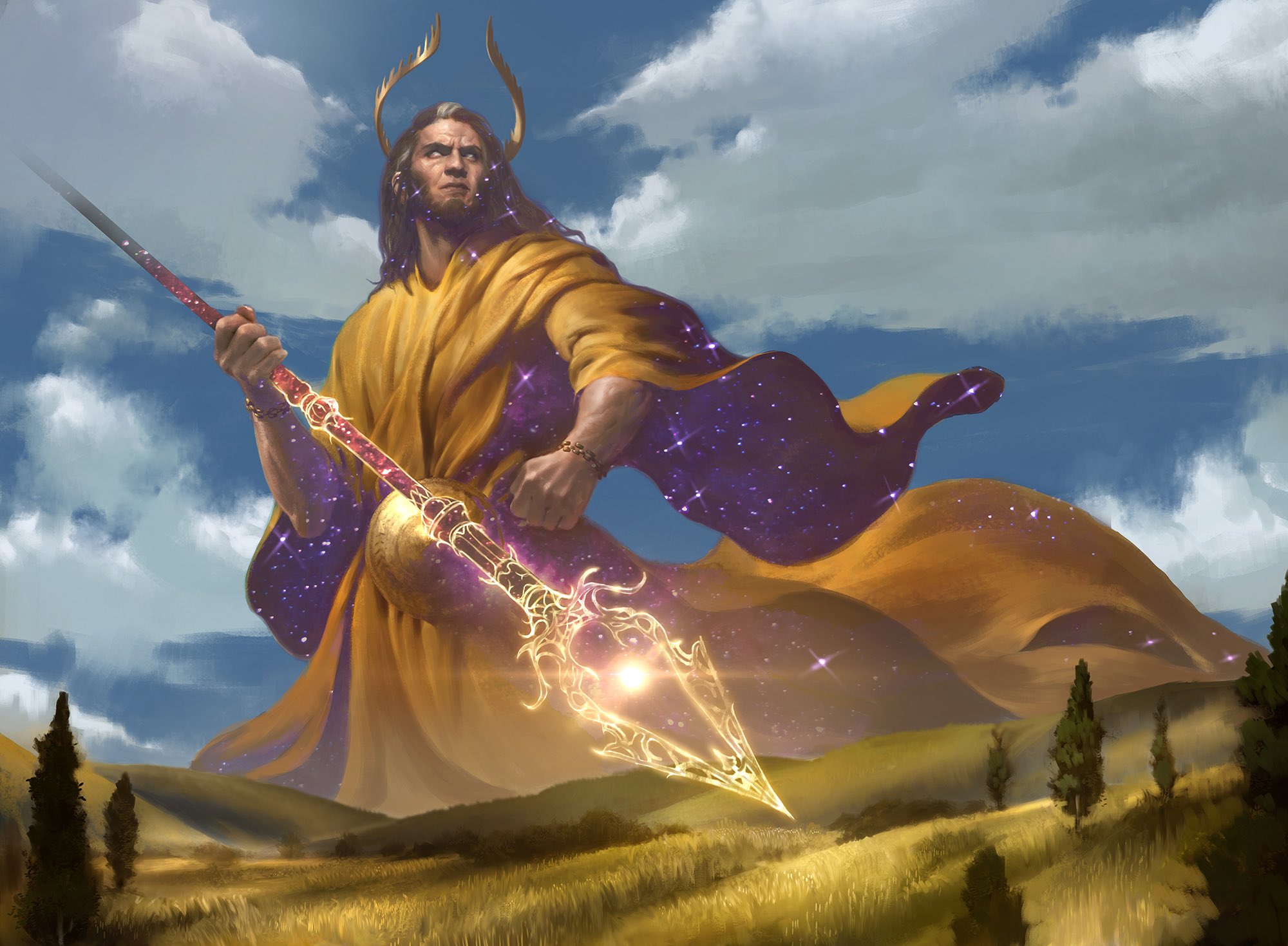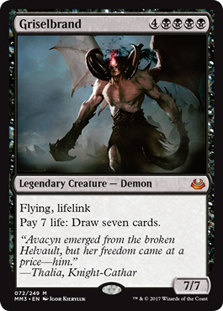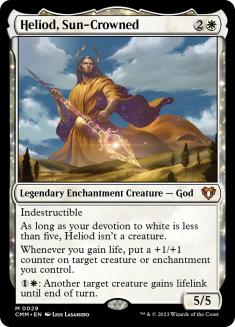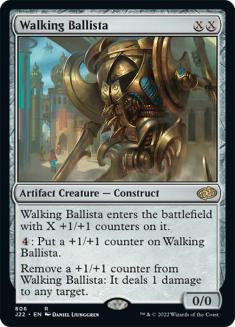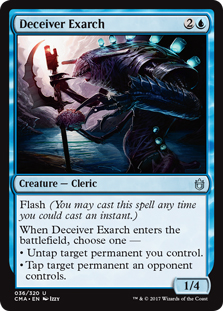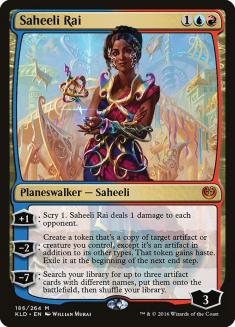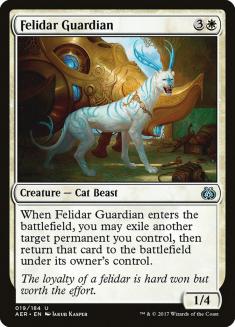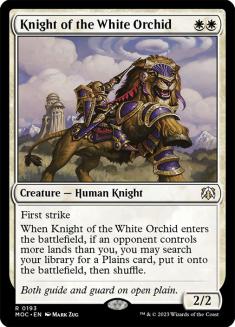Two-card instant-win combos have been a part of Magic’s history for many years. Sometimes they’re not format-breaking, especially in Legacy and Vintage. We’ve had Show and Tell with Griselbrand as well as Entomb / Reanimate.
Sometimes they’re a little too good, like the now-banned Flash / Protean Hulk, Illusions of Grandeur / Donate, Felidar Guardian / Saheeli Rai, or Deceiver Exarch / Splinter Twin.
Creatures (11)
Lands (18)
Spells (31)

With the release of Theros Beyond Death, Heliod, Sun-Crowned brings a new combo to the table with old favorite Walking Ballista.
Here’s how it works. With Walking Ballista at least a 2/2, you activate Heliod targeting the Ballista. Then, start pinging your opponent with the Ballista. Every time you hit them, you gain a life. Every time you gain a life, you get to add a +1/+1 counter to Walking Ballista. Rinse, repeat, opponent loses. Simple enough, right?
Heliod, Sun-Crowned and Walking Ballista will go firmly in the too-good pile in Pioneer. Let’s talk about why.
1. Heliod is hard to interact with.
Of the famous two-card instant-win combos, the best ones have always been the pairs where the pieces require specific types of interaction to actually stop. For example, with Deceiver Exarch, the fact that it could be cast as an instant meant that opponents would be required to hold up some amount of mana in order to even hope to answer it in their own end step. There were numerous protection spells the Twin player could use in order to defend themselves, and Exarch itself tapped down one land to make interaction even more difficult.
Not to mention, four toughness is hard to deal with! Lightning Bolt didn’t touch Exarch, which was a big part of its appeal.
Now, Heliod is different. Heliod doesn’t have flash, but it does have indestructible, and it’s not even a creature without a requisite devotion to white. Quick: name all the cards in Pioneer that answer a noncreature Heliod!

Banishing Light is probably the best of the bunch (if you’re not going to go super-narrow with stuff like Deicide or Unravel the Aether).
Even if it is a creature, the common removal in Pioneer isn’t getting around indestructible. Fatal Push, Wild Slash, Swift End, and the like are not answering this God once it hits the battlefield. It’s important to have your “first half” of your two-card combo be as tough to profitably answer as possible, and Heliod ticks that off with flying colors.
And when it’s a creature…
2. Heliod is a powerful card on its own.
Deceiver Exarch is a serviceable but not exciting creature on its own. If it weren’t for the combo with Splinter Twin, no one would play it in Constructed. Splinter Twin itself? Don’t make me laugh.
Saheeli Rai is also barely playable on its own, and mostly just for incidental synergies with things like Wall of Omens, Snapcaster Mage, or Rogue Refiner in various shells.
Felidar Guardian? Again, a sweet card, but it would only be playable on its own at two, not four mana.
But Heliod, Sun-Crowned? It’s not even that unreasonable to put him in a normal Soul Sisters-esque deck. And we all know that Walking Ballista is one of the best artifact creatures of all time, offering removal and a mana sink to any deck in Magic. Any combo that incidentally rides with Walking Ballista is automatically going to be better for having it.
3. Both parts of the combo are proactive.
It’s all the better when your two-card combo also lends itself to a robust aggro plan, as you can design a deck to be more aggro, more combo, or even leverage a change-up via the sideboard to keep opponents guessing. Some of the most effective decks in Magic’s history have been the great combo-control decks, like the aforementioned Splinter Twin and Four-Color Saheeli archetypes.
Creatures (19)
- 1 Tireless Tracker
- 1 Ishkanah, Grafwidow
- 3 Whirler Virtuoso
- 4 Servant of the Conduit
- 3 Rogue Refiner
- 3 Walking Ballista
- 4 Felidar Guardian
Planeswalkers (6)
Lands (12)
Spells (23)

Both were able to leverage their sideboards to shift focus and diversify their threats, forcing opponents to respect the possibility of a combo that might not even be in the gameplan! Four-Color Saheeli became a midrange deck with planeswalkers, and Splinter Twin changed it up with the powerful Keranos, God of Storms.
Of course, aggro-combo is a potent recipe for success as well. Most combo decks with creatures have a fairly anemic beatdown plan, though various Elves decks have managed to cobble it together over the years. Affinity decks have always threatened a combo kill with cards like Disciple of the Vault or Inkmoth Nexus, and Hogaak decks sort of straddled the line with nickel-and-dime beatdown through hardcast Vengevines, Bloodghasts and Carrion Feeders despite graveyard hate.
But Heliod/Ballista is an easy sell in a normal beatdown shell. After all, normal white creatures seem to go well with the aggro plan, and with a high devotion count, this version of the deck maximizes Heliod as a creature.
Creatures (29)
- 4 Knight of the White Orchid
- 4 Mardu Woe-Reaper
- 2 Kytheon, Hero of Akros
- 4 Walking Ballista
- 4 Benalish Marshal
- 4 Dauntless Bodyguard
- 3 Daxos, Blessed by the Sun
- 4 Heliod, Sun-Crowned
Planeswalkers (4)
Lands (5)
Spells (22)

My kingdom for a Kabira Crossroads!
But seriously, Gideon’s emblem, Daxos’s enters-the-battlefield lifegain trigger, Mardu Woe-Reaper’s trigger, Radiant Fountain’s trigger, and Benalish Marshal’s +1/+1 to all other creatures all have the same effect. They allow your Walking Ballista to combo off that very turn as a mere 1/1. Here’s the deal with the combo: without a way to incidentally juice up your Walking Ballista to a 2/2 or better, you need to spend a full four mana on the thing, then spend another two mana to actually give it lifelink, and then finally run out the combo. So a 1/1 Ballista won’t cut it. But with an Anthem effect or an incidental lifegain trigger, you can immediately bump up the Ballista to a 2/2 and get the ball rolling.
But this deck is just a starting point. There have to be better ways to improve consistency and power, whether it’s leaning on devotion more and playing Nykthos, or adding a second color to get some better removal or recursion.
And yes, the sideboard of a deck like this should almost certainly include Archangel Avacyn and Selfless Spirit, though a slower, more devotion-oriented version might do better to just play them both maindeck. If we’re interested in a higher-power plan, though, this might do the trick.
What about Mono-White Eldrazi?
Creatures (31)
- 4 Knight of the White Orchid
- 4 Eldrazi Displacer
- 4 Thought-Knot Seer
- 4 Archangel Avacyn
- 4 Thraben Inspector
- 4 Selfless Spirit
- 4 Walking Ballista
- 3 Heliod, Sun-Crowned
Lands (15)
Spells (14)

To be honest, the most exciting part about this deck is Knight of the White Orchid, possibly the only card in Pioneer that does anything to ameliorate the massive disadvantage of being on the draw.
Knight of the White Orchid also finds Temple Garden…
Temple Garden also casts Collected Company…
Collected Company finds Heliod, Sun-Crowned (though sadly it doesn’t do well with Walking Ballista, unless there’s an Anthem effect on the battlefield)…
Creatures (34)
- 4 Knight of the White Orchid
- 4 Scavenging Ooze
- 4 Thraben Inspector
- 2 Tireless Tracker
- 4 Spell Queller
- 3 Selfless Spirit
- 4 Walking Ballista
- 2 Knight of Autumn
- 4 Deputy of Detention
- 3 Heliod, Sun-Crowned
Lands (20)
Spells (6)

It’s possible that a better choice is to lean more green and play the Llanowar Elves / Elvish Mystic package. After all, there’s plenty to do with one’s mana in a deck like this!
One could also play Shared Summons, but now we’re getting into “extremely cute and probably too slow” territory. Better to play cards that we know are good. Which leads to the best version of the deck.
More exciting than Temple Garden, Knight of the White Orchid finds Godless Shrine. Black is the best color in Pioneer (what with Fatal Push and Thoughtseize, two Legacy all-stars, being legal in this format for some reason), so Orzhov Heliod might be just the ticket, as it can easily switch to a midrange shell and gets to play cool cards like Whip of Erebos for incidental value and recursion!
Creatures (20)
- 4 Knight of the White Orchid
- 2 Kalitas, Traitor of Ghet
- 4 Walking Ballista
- 4 Knight of the Ebon Legion
- 3 Murderous Rider
- 3 Heliod, Sun-Crowned
Planeswalkers (3)
Lands (21)
Spells (16)
Sideboard

Tell me you aren’t ready to transform post-sideboard and Whip of Erebos back an Obzedat like it was 2014 again! With Liliana, the Last Hope to recur either half of the combo and provide insane suppression for the many X/1s that live in Pioneer right now, this deck is tremendously exciting.
If we lean away from Knight of the White Orchid, though, we open up the possibility of Mardu Vehicles, a cutthroat aggro deck with a nice healthy backup plan of a combo. This is the go-to option worth serious consideration as a ready-to-play Heliod/Ballista deck, and what I’ll take to the Pioneer Leagues and local tournaments to dip my toes in the new Pioneer waters:
Creatures (24)
- 4 Thraben Inspector
- 2 Bomat Courier
- 4 Scrapheap Scrounger
- 4 Toolcraft Exemplar
- 4 Walking Ballista
- 4 Bonecrusher Giant
- 2 Heliod, Sun-Crowned
Planeswalkers (4)
Lands (20)
Spells (12)

The fact that the combo only demands a small amount of white mana means that the possibilities are staggering. One can play Mono-White Aggro, Mono-White Devotion, base-green, Orzhov, or even Mardu Vehicles. There are probably even more options out there; Esper Vehicles or Abzan Delirium come to mind as two on the verge of greatness.
One thing is for certain, though. With a two-card infinite combo, built-in resilience, interaction, and a low deckbuilding commitment, something with Heliod and Walking Ballista is going to break into the top tier of Pioneer very soon.

